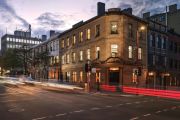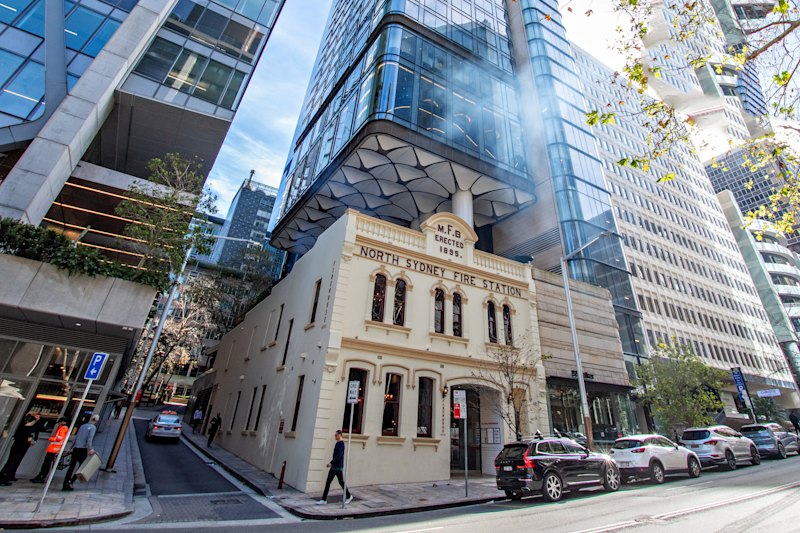
Ten of Sydney's favourite office buildings - and why we love them
Sydney is home to many buildings known for their architecture, their history and their importance to the city’s commercial history – and all with a story to tell.
Some of these buildings opened their doors during Sydney Open 2016, offering the rare chance to see inside the spaces that define our streetscapes.
Here, inspired by the recent Sydney Open, we show you 10 buildings that are particularly significant to the city – and the reasons we love them.
 City heartbeat: The building at 155 Clarence Street is best known as the former Red Cross House. Photo: Supplied
City heartbeat: The building at 155 Clarence Street is best known as the former Red Cross House. Photo: Supplied
Built in 1939, this art moderne building started as a warehouse and became best known as Red Cross House, having its finger on the pulse of the city between 1974 and 2011 when it served as headquarters to the Red Cross Society and blood transfusion centre.
Since its refurbishment was completed in 2014, the heritage building near Wynyard Station has served as A-grade office space.
Why we love it: The signature clock on the facade.
 Pink palace: 48 Martin Place, Sydney. Photo: Louise Kennerley
Pink palace: 48 Martin Place, Sydney. Photo: Louise Kennerley
The building was completed in 1928 and has a stately history as head office for the Government Savings Bank of NSW.
The grand banking chamber on ground level faces Martin Place, Castlereagh and Elizabeth streets.
Known as the “pink palace”, the building has a distinctive terracotta and pink granite exterior in the beaux-arts style.
Why we love it: The spectacular atrium and sheer vertical space below at the new headquarters of Macquarie Group – as well as the building’s six-star rating from the Green Building Council of Australia.
 The atrium inside 50 Martin Place. Photo: Haley Richardson
The atrium inside 50 Martin Place. Photo: Haley Richardson
 Talk of the town. Photo: 8chifley.com.au
Talk of the town. Photo: 8chifley.com.au
Built in 2013, 8 Chifley’s award-winning history began with its design, which was decided by an international competition.
Rogers Stirk Harbour + Partners and its local partners, the Lippmann Partnership, came up with a non-traditional design incorporating multi-level commercial “vertical villages”, with two having outdoor terraces.
Digital artwork by Jenny Holzer displays texts written by Aboriginal and Torres Strait Islander people around a 19-metre steel column day and night, a talking point among passers-by.
Why we love it: The recognisable red “suspenders” on the building’s exterior.
 Digital artwork at 8 Chifley. Photo: Rebecca Holland
Digital artwork at 8 Chifley. Photo: Rebecca Holland
 Hidden Seidler gem: 9 Castlereagh Street. Photo: Courtesy of Steensen Vaming
Hidden Seidler gem: 9 Castlereagh Street. Photo: Courtesy of Steensen Vaming
At 30 metres wide and 42 metres long, relatively restrictive for a tall building, the site posed a challenge for architect Harry Seidler in 1989.
He tackled the task with hollow atrium modules, which enabled the structure to double the permitted height for the area and reach 31 storeys.
This building, one of Seidler’s lesser-known projects, is considered a hidden architectural gem.
Why we love it: The grand lobby with a 10-metre glass wall and a tiled mural by Lin Utzon, the daughter of Sydney Opera House architect Jorn Utzon. Danish architecture company Steensen Varming, which was brought to Australia by the Sydney Opera House project, has its office space on the eighth floor.
 Ahead if its time: AMP Building, Circular Quay. Photo: Commercial Real Estate
Ahead if its time: AMP Building, Circular Quay. Photo: Commercial Real Estate
In 1962, the 107-metre AMP Building at Circular Quay was more than twice the height of any other structure in Sydney except for the AWA Tower.
Its modern style was ahead of its time and the viewing deck on its top floor, the 26th storey, offered new views above the city and harbour.
Why we love it: The curved facade that sets it apart from the standard rectangles and squares among buildings of the era.
 ‘Doughnut’ design: Australia Square building in George Street, Sydney. Photo: Robert Pearce
‘Doughnut’ design: Australia Square building in George Street, Sydney. Photo: Robert Pearce
Australia Square once held a record as the world’s tallest reinforced concrete structure and its circular design captured international attention.
It was designed by Harry Seidler, built between 1961 and 1967 and now considered an architectural icon, becoming Sydney’s first skyscraper of the time.
The 52-storey circular building has a “doughnut” design in its 42-metre diameter, with the central core housing lifts and utilities. Thirty buildings on the site were demolished to make way for the project.
Why we love it: Its visionary community plaza concept and its “architectural exclamation mark” nickname.
 The new EY Centre at 200 George Street opened officially in June 2016. Photo: Alexander Mayes Photography
The new EY Centre at 200 George Street opened officially in June 2016. Photo: Alexander Mayes Photography
Sydney’s newest office tower, the 37-storey EY Centre at 200 George Street, is also its smartest – and not just in looks.
Technology taps into its structure and monitors its occupants to help manage the building and improve collaboration and business practices. Sensors and beacons gather information on how people use the space as well as intelligence around the performance of the building itself.
Wooden louvres inside the building’s closed-cavity facade, an Australian first designed by FJMT Studio, create a golden shimmer effect around the building.
Why we love it: Thousands of historical artefacts unearthed during excavation works are on display to the public in glass cases along a stairway outside the building.
 Looking down into the lobby at Deutsche Bank Place. Photo: Courtesy Deutsche Bank Place
Looking down into the lobby at Deutsche Bank Place. Photo: Courtesy Deutsche Bank Place
The building at 126 Philip Street and its triangular exoskeleton, known as Sydney’s goal posts, appeared on the skyline in 2005.
Its wide, single-span floor plates are the biggest of their type in Australia, allowing maximum flexibility for the office fit-out and tenants’ requirements.
Why we love it: The constantly changing light through the glass and the fast-moving glass lifts with great views of inside the building and outside to the city. Don’t look down.
 The Deutsche Bank building “goal posts” behind 8 Chifley. Photo: Commercial Real Estate
The Deutsche Bank building “goal posts” behind 8 Chifley. Photo: Commercial Real Estate
 Forward thinking: Grosvenor Place was built for the future. Photo: Jennifer Soo
Forward thinking: Grosvenor Place was built for the future. Photo: Jennifer Soo
The late 1980s was all about big business and big plans.
Harry Seidler’s brief was to create something with long-term value. Grosvenor Place, with a forward thinking, energy-conscious design that conserves energy, reduces glare and minimises airconditioning requirements, was completed in 1988.
The complex includes the historical Johnsons Building, Federation House and Royal Naval House. Controversially, Seidler wanted to demolish the Johnsons Building facade to enhance the space but the plan was rejected.
Why we love it: The twin convex camera lens-shaped facades of the 44-floor building. It’s no wonder photographer Max Dupain describes Grosvenor Place “a visual treat”.
 Eye in the sky: Grosvenor Place from above. Image: Google Maps
Eye in the sky: Grosvenor Place from above. Image: Google Maps
 Governor Macquarie Tower and Governor Phillip Tower. Photo: onefarrerplace.com
Governor Macquarie Tower and Governor Phillip Tower. Photo: onefarrerplace.com
The 64-storey Governor Phillip and 46-storey Governor Macquarie towers, which share a foyer under a glass roof, are on a block bounded by Bridge, Bent, Phillip and Young streets also occupied by the Museum of Sydney and First Government House Place.
The area is historically significant to Sydney because some of the city’s earliest civic leaders surveyed the colony from the elevated vantage point.
Archaeologists unearthed foundations of the original Government House at the site in 1980.
Why we love it: The premium-grade office complex represents perhaps the earliest connection to commercial property in Sydney, dating back to settlement in 1788.
- In case you missed it: See the full list of Sydney Open buildings at Sydney Living Museums.










